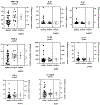Clinical, Immunologic, and Genetic Characteristics in Patients With Syndrome of Undifferentiated Recurrent Fevers
- PMID: 39622767
- PMCID: PMC12208190
- DOI: 10.1002/art.43065
Clinical, Immunologic, and Genetic Characteristics in Patients With Syndrome of Undifferentiated Recurrent Fevers
Abstract
Objective: Syndrome of undifferentiated recurrent fevers (SURF) is characterized by recurrent fevers and autoinflammation without a confirmed molecular diagnosis of a hereditary recurrent fever syndrome, and not fulfilling criteria for periodic fever, adenitis, pharyngitis, aphthous stomatitis syndrome (PFAPA). The goal of this study was to characterize clinical features of patients with SURF compared to patients with PFAPA and to analyze their cytokine signature, genetic variations, and responses to treatment.
Methods: We enrolled 46 patients observed at Cincinnati Children's Hospital Medical Center. Baseline data and inflammatory cytokines were collected at enrollment, and their clinical course was followed. Cytokine analysis was performed using a cytokine multiplex assay. Many patients had specific or whole exome genetic testing.
Results: The prevalence of rash and arthralgias were higher in patients with SURF compared to patients with PFAPA. Pharyngitis and adenopathy were less frequent. A subset of patients with SURF clustered together with elevated proinflammatory cytokines and more frequently required biologic therapy. Focused analysis of whole exome sequencing data revealed that variants of unknown clinical significance (VUCS) were frequently identified in genes implicated in B cell development, immunodeficiencies, and inflammatory bowel disease risk. Treatments for patients with SURF commonly included on-demand steroids, colchicine, and anti-interleukin-1 therapy.
Conclusion: Our findings suggest SURF is a heterogeneous group but has distinct clinical and immunologic features from disorders such as PFAPA. Patients have frequent VUCS, which may have relevance to disease pathogenesis. A subset of patients showed more inflammation and an increased need for biologic therapy. Further research is necessary to define whether there exist distinct SURF endotypes and to better predict treatment outcomes.
© 2024 American College of Rheumatology.
Figures



References
-
- Gattorno M, Hofer M, Federici S, et al. ; Eurofever Registry and the Paediatric Rheumatology International Trials Organisation (PRINTO). Classification criteria for autoinflammatory recurrent fevers. Ann Rheum Dis 2019;78(8):1025–1032. - PubMed
-
- Manthiram K, Zhou Q, Aksentijevich I, et al. The monogenic autoinflammatory diseases define new pathways in human innate immunity and inflammation. Nat Immunol 2017;18(8):832–842. - PubMed
-
- Romano M, Arici ZS, Piskin D, et al. The 2021 EULAR/American College of Rheumatology points to consider for diagnosis, management and monitoring of the interleukin-1 mediated autoinflammatory diseases: cryopyrin-associated periodic syndromes, tumour necrosis factor receptor-associated periodic syndrome, mevalonate kinase deficiency, and deficiency of the interleukin-1 receptor antagonist. Ann Rheum Dis 2022;81(7):907–921. - PubMed
-
- Cetin Gedik K, Lamot L, Romano M, et al. The 2021 European Alliance of Associations for Rheumatology/American College of Rheumatology Points to Consider for Diagnosis and Management of Autoinflammatory Type I Interferonopathies: CANDLE/PRAAS, SAVI, and AGS. Arthritis Rheumatol 2022;74(5):735–751. - PubMed
MeSH terms
Substances
Supplementary concepts
Grants and funding
LinkOut - more resources
Full Text Sources
Medical

